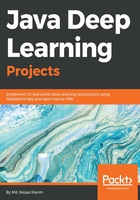
Cloud-based platforms for DL
Apart from the preceding libraries, there have been some recent initiatives for deep learning on the cloud. The idea is to bring deep learning capabilities to big data with millions of billions of data points and high-dimensional data. For example, Amazon Web Services (AWS), Microsoft Azure, Google Cloud Platform, and NVIDIA GPU Cloud (NGC) all offer machine and deep learning services that are native to their public clouds.
In October 2017, AWS released deep learning Amazon Machine Images (AMIs) for Amazon Elastic Compute Cloud (EC2) P3 instances. These AMIs come pre-installed with deep learning frameworks, such as TensorFlow, Gluon, and Apache MXNet, that are optimized for the NVIDIA Volta V100 GPUs within Amazon EC2 P3 instances.
The Microsoft Cognitive Toolkit is Azure's open source, deep learning service. Similar to AWS's offering, it focuses on tools that can help developers build and deploy deep learning applications.
On the other hand, NGC empowers AI scientists and researchers with GPU-accelerated containers (see https://www.nvidia.com/en-us/data-center/gpu-cloud-computing/). NGC features containerized deep learning frameworks such as TensorFlow, PyTorch, MXNet, and more that are tuned, tested, and certified by NVIDIA to run on the latest NVIDIA GPUs.
Now that we have a minimum of knowledge about available DL libraries, frameworks, and cloud-based platforms for running and deploying our DL applications, we can pe into coding. First, we will start by solving the famous Titanic survival prediction problem. However, we won't use the previously listed frameworks; we will be using the Apache Spark ML library. Since we will be using Spark along with other DL libraries, knowing a little bit of Spark would help us grasp things in the upcoming chapters.